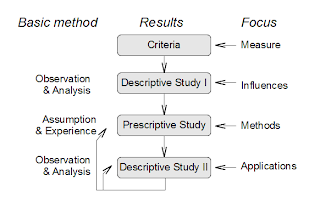The design process was scoped by the four stages of the DRM, seen in figure below, although the actual artefacts were developed in a nonlinear fashion. All four stages contributed to new learning, which is included in the respective chapters of the thesis.
 |
| The four stages of the Design Research Methodology by Blessing and Chakrabarti |
Criteria
The first stage in the design process defined the overall context, research questions and design goals based on cases~I-V in together with selected problems form published literature, described in detail in chapter 2. Chapters 5 and 6 provides a rich insight into the industrial context of mass-produced embedded systems.Descriptive Study I
The second stage investigated existing literature to further understand the problems, elaborated on evaluation criteria and guided to possible solutions, this is described in chapter 7. The aim of this investigation is to answer RQ1 and guide towards answers of answer RQ1.1 and RQ1.2.Prescriptive Study
The third stage, the Prescriptive Study, investigated specific artefacts related to RQ1.1, RQ1.2, RQ1.3 and RQ1.4.This resulted in a set of artefacts to achieve the goals and alleviate problems identified in the previous two stages. The artefacts fall into several categories of ways-of-working, model and architectures:
- Chapter 7 describes a model of how individual teams interact with large projects, and based on this a method to facilitate a transition to agile development for individual teams.
- Chapters 9 and 11 describe two architectures, for compositional architectures and embedded architecture for innovation experiment systems respectively.
- Chapter 10 describes 5 activities to establish an open software ecosystem for MPES.
Descriptive Study II
The fourth stage evaluated the resulting artefacts, methods and ways-of-working in cases VI-VIII from the previous stage (also the focus of chapters 7, 9, 10 and 11).Limitations
The artefacts were evaluated mainly through observational, analytical and descriptive methods as categorised by Hevner et al:- Observation through case studies
- Architectural analysis of designed artefacts
- Informed argument based on insider knowledge to show the artefact's utility
- Scenarios describing the use of the artefact in the context
The DRM process assumes an iteration of the last two phases to optimise the design of the artefacts against the design goals, in this project only one cycle was performed.
The set of artefacts is not sufficient for an organisation to evolve its R&D process, in practice there are numerous other factors affecting the efficiency of an R&D process at an OEM. Factors from almost every area of research, ranging from management theory via economics to semiconductor technology. The set of artefacts developed is thus shown to mitigate the investigated problems, but not necessarily solve them, at least not on their own.
No comments:
Post a Comment